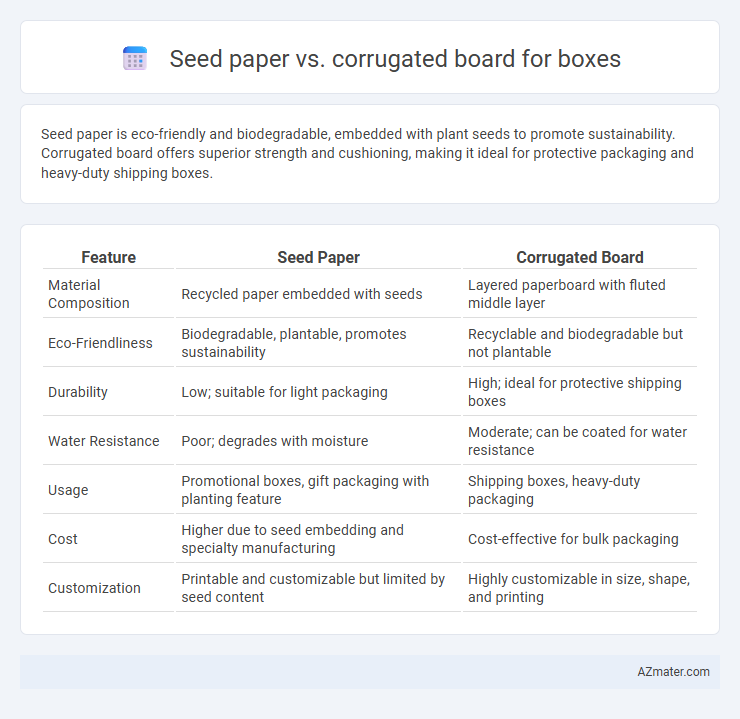Seed paper is eco-friendly and biodegradable, embedded with plant seeds to promote sustainability. Corrugated board offers superior strength and cushioning, making it ideal for protective packaging and heavy-duty shipping boxes.
Table of Comparison
| Feature | Seed Paper | Corrugated Board |
|---|---|---|
| Material Composition | Recycled paper embedded with seeds | Layered paperboard with fluted middle layer |
| Eco-Friendliness | Biodegradable, plantable, promotes sustainability | Recyclable and biodegradable but not plantable |
| Durability | Low; suitable for light packaging | High; ideal for protective shipping boxes |
| Water Resistance | Poor; degrades with moisture | Moderate; can be coated for water resistance |
| Usage | Promotional boxes, gift packaging with planting feature | Shipping boxes, heavy-duty packaging |
| Cost | Higher due to seed embedding and specialty manufacturing | Cost-effective for bulk packaging |
| Customization | Printable and customizable but limited by seed content | Highly customizable in size, shape, and printing |
Introduction to Sustainable Packaging Materials
Seed paper and corrugated board are innovative sustainable packaging materials designed to reduce environmental impact while maintaining functional durability. Seed paper integrates biodegradable fibers embedded with seeds, promoting zero waste through planting after use, whereas corrugated board is made from recycled paper fibers, offering strong, lightweight protection with high recyclability. Both materials cater to eco-conscious brands aiming to minimize carbon footprint and enhance consumer engagement by leveraging renewable resources in packaging solutions.
What Is Seed Paper?
Seed paper is an innovative eco-friendly material embedded with seeds, designed to be planted after use, promoting sustainability and reducing waste in packaging. Unlike corrugated board, which is a sturdy, multi-layered paperboard primarily made from recycled paper for durability and protection, seed paper combines functionality with environmental benefits by enabling plant growth post-disposal. This biodegradable material is ideal for companies seeking to enhance their brand's eco-conscious image while providing packaging that actively contributes to environmental regeneration.
Understanding Corrugated Board
Corrugated board consists of a fluted corrugated sheet sandwiched between two flat linerboards, providing superior strength and cushioning for box applications compared to seed paper. This material excels in protecting heavy or fragile items during shipping due to its high rigidity and resistance to impact. Unlike seed paper, which is biodegradable and eco-friendly but lacks durability, corrugated board offers cost-effective, reliable packaging solutions widely used across industries.
Environmental Impact: Seed Paper vs Corrugated Board
Seed paper decomposes naturally, enriching soil by releasing embedded seeds that promote plant growth, making it highly biodegradable and eco-friendly. Corrugated board, while recyclable and often made from recycled materials, requires energy-intensive production and may generate waste if contaminated or coated with non-recyclable substances. The environmental impact of seed paper is generally lower due to its dual function of packaging and supporting plant life, whereas corrugated board offers durability but with a larger carbon footprint.
Strength and Durability Comparison
Seed paper boxes and corrugated board boxes differ significantly in strength and durability; seed paper, embedded with biodegradable seeds, offers eco-friendly benefits but generally lacks the structural integrity required for heavy or long-term storage. Corrugated board, made from multiple layers of recycled paperboard, provides superior strength, impact resistance, and moisture durability, making it ideal for shipping and protecting fragile items. For applications demanding robust protection and longevity, corrugated board remains the preferred choice over seed paper.
Printing and Customization Options
Seed paper offers unique customization opportunities with vibrant, eco-friendly inks that enhance its textured surface, ideal for botanical branding and limited-edition packaging. Corrugated board supports high-quality flexographic and digital printing techniques, allowing detailed graphics and full-color designs suitable for mass production. Both materials provide distinct printing advantages: seed paper excels in niche, tactile appeal while corrugated board ensures durability and scalability in customization.
Cost Analysis: Seed Paper vs Corrugated Board
Seed paper typically incurs higher material costs compared to corrugated board due to its specialty composition embedded with plant seeds, which increases production complexity and price. Corrugated board offers a cost-effective solution with lower raw material expenses and widespread manufacturing infrastructure, resulting in competitive pricing for bulk packaging needs. When evaluating total expenses, seed paper may incur additional costs linked to limited suppliers and niche market demand, while corrugated board benefits from economies of scale and recyclability advantages.
Biodegradability and End-of-Life Solutions
Seed paper offers exceptional biodegradability due to its natural composition embedded with plant seeds, enabling effortless soil integration and plant growth after disposal. Corrugated board, comprised of recycled paper fibers, provides strong recyclability but requires industrial composting or recycling facilities to degrade effectively. Both materials promote sustainable end-of-life solutions, with seed paper favoring direct environmental regeneration and corrugated board supporting conventional waste management systems.
Use Cases and Market Applications
Seed paper is ideal for eco-friendly packaging, promotional materials, and gift boxes where sustainability and plantability are key selling points, often used in the gardening industry and green marketing campaigns. Corrugated board excels in heavy-duty shipping boxes, retail packaging, and industrial containers due to its durability, cushioning properties, and cost-effectiveness in logistics and e-commerce sectors. Both materials address distinct market needs: seed paper targets biodegradable and reusable packaging for niche markets, while corrugated board serves mainstream demands for protection and stacking in global supply chains.
Choosing the Right Material for Your Packaging Needs
Seed paper offers eco-friendly benefits with its biodegradable properties and ability to sprout plants, making it ideal for sustainable packaging. Corrugated board provides superior strength, cushioning, and durability, perfect for heavy-duty shipping and protection. Evaluate your packaging needs for sustainability, product protection, and budget to select the most suitable material.

Infographic: Seed paper vs Corrugated board for Box
 azmater.com
azmater.com